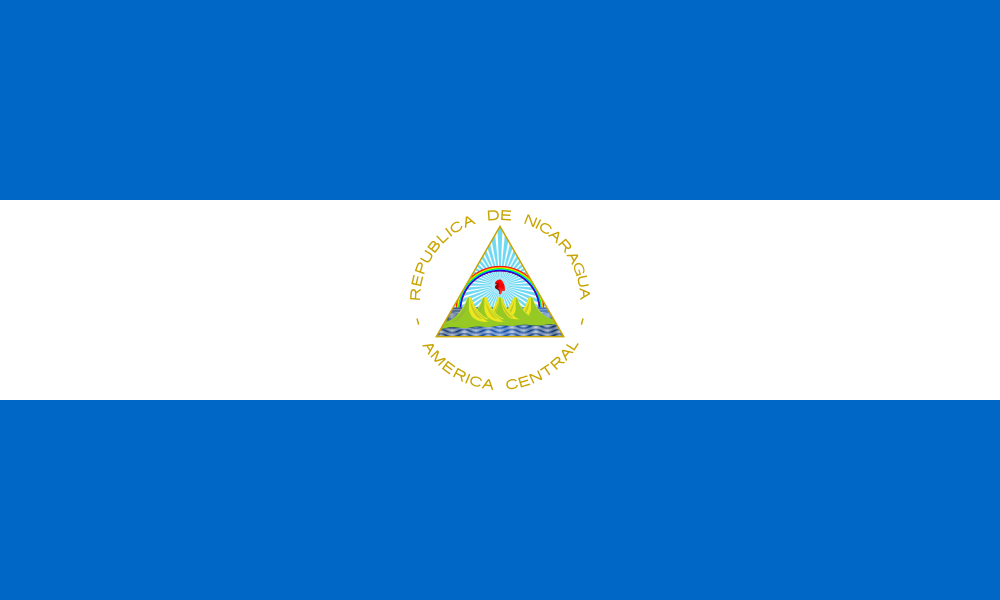Design and Coloration:
The national flag of Nicaragua is characterized by three horizontal stripes, each of equal width, positioned from top to bottom. These stripes feature distinct colors: a captivating blue, often referred to as "Cobalt Blue" or "Prussian Blue," flanked by two vibrant white bands. This tricolor arrangement spans the full breadth of the flag's canvas.
- Top Blue Stripe: This uppermost azure stripe artfully represents the Caribbean Sea, which graces the eastern borders of Nicaragua. Its evocative symbolism extends beyond geography to encompass the nation's historical association with the Atlantic Ocean, as well as its maritime heritage. The deep blue hue resonates with the expanse of the sky, echoing ideals such as liberty and justice.
- Central White Stripe: The immaculate white stripe positioned at the heart of the flag carries profound significance. It embodies concepts of tranquility, unity, and moral virtue. A beacon of Nicaragua's aspirations for internal cohesion and collaboration among its diverse populace, the white stripe metaphorically bridges the two blue sections, vividly illustrating Nicaragua's pivotal role in connecting the realms of the Atlantic and Pacific within Central America.
- Bottom Blue Stripe: Similar to its celestial counterpart above, this lower blue stripe serves as an emblematic representation of the Pacific Ocean that embraces Nicaragua's western shores. Beyond denoting a geographical expanse, it serves as a testament to the nation's relationship with the Pacific, highlighting avenues for commerce, cultural exchange, and its strategic position as a conduit uniting the Americas.
Historical and Cultural Depth:
The flag of Nicaragua is steeped in historical significance, woven intricately with the tapestry of the nation's journey towards independence and sovereignty:
- Roots of Revolution: The flag's design encapsulates the tenets of the Central American independence movement of the 19th century. The interwoven blue and white palette harkens back to the ensign of the United Provinces of Central America—a transient political entity Nicaragua was a part of following its liberation from Spanish colonial rule.
- Identity of Nicaragua: Beyond mere symbolism, the flag embodies Nicaragua's unique national identity within the broader spectrum of Central America. The resounding blue and white shades resonate with the landscapes of the nation, encompassing both celestial expanses and terrestrial beauty, including the awe-inspiring oceans and boundless skies.
- National Emblem: Though the flag is often displayed in its pristine tricolor form, official and formal occasions may feature the addition of the national coat of arms at the center of the white band. This emblem includes five volcanoes symbolizing the five Central American nations, a vibrant rainbow, and the emblematic Phrygian cap—a timeless emblem of freedom.
Prominent Display and Usage:
The flag of Nicaragua is a ubiquitous presence throughout the nation, finding itself unfurled in various settings and events:
- Seat of Government: Adorning government edifices, official residences, and institutions, the flag stands as a visual testament to national authority and unwavering unity.
- Communal Celebrations: Raised during national holidays, festivities, and commemorative occasions, the flag becomes a palpable expression of patriotism, paying homage to the country's storied past.
- Public Gatherings: It's a ubiquitous sight at public rallies, gatherings, and ceremonies, serving as a poignant embodiment of Nicaraguan heritage and values.
- Athletic Pursuits: During sporting events, especially international competitions, the flag unfurls with vigor, rallying fervent support for national teams and athletes.
- Education Hubs: In the realm of education, the flag takes on a vital role, fostering awareness about Nicaragua's historical narrative, geographic uniqueness, and vibrant culture.
In its unassuming yet profoundly meaningful design, the flag of Nicaragua emerges as a potent emblem, encapsulating the annals of the nation's past, present, and aspirations for the future. It stands as a vivid representation of the struggles, dreams, and unity of the Nicaraguan people, serving as an unbreakable bond linking the vast realms of the Atlantic and Pacific Oceans.
Last Updated on: August 18, 2025
